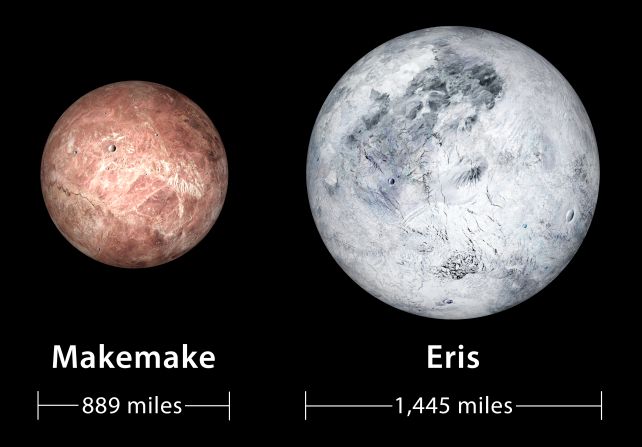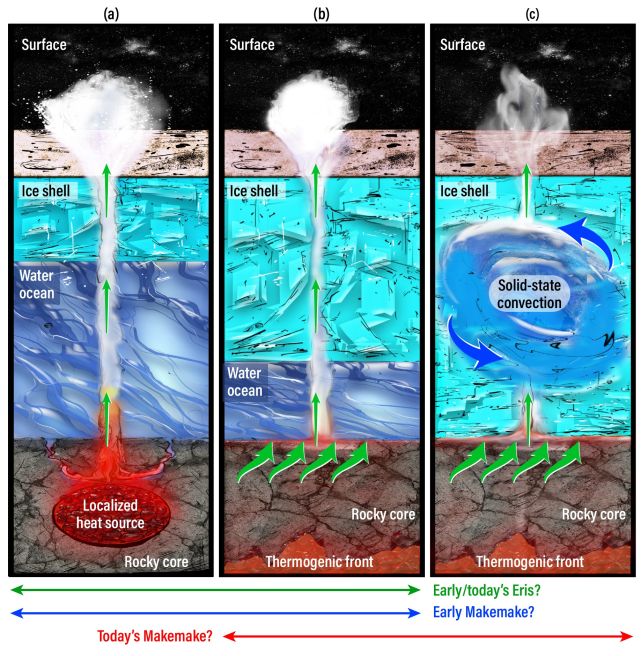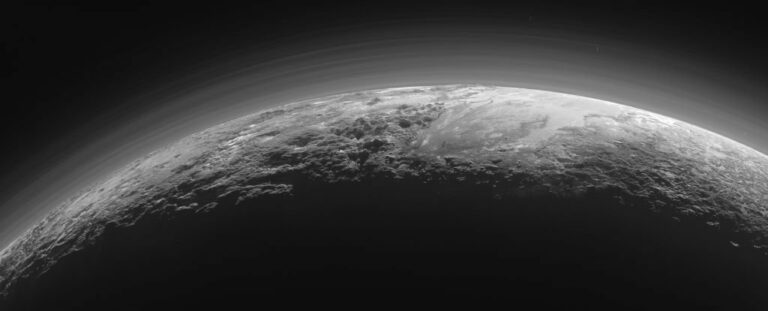Dwarf planets located at the frozen edge of our solar system may potentially conceal warm oceans.
Beyond the orbit of Pluto lies the Kuiper Belt, a region filled with icy rocks and dwarf planets that are believed to be extremely cold. Recent discoveries, however, have shown that Eris and Makemake, two dwarf planets in the Kuiper Belt, may be hiding secrets beneath their frozen exteriors. The presence of methane with isotope ratios consistent with internal heating suggests that these distant worlds may have hidden oceans beneath their icy surfaces.
This surprising revelation challenges previous assumptions about the Kuiper Belt objects and highlights the need for further exploration and study.

Eris and Makemake, two dwarf planets, are smaller and located farther away from the Sun compared to Pluto. Pluto has a radius of 1,188 kilometers (738 miles) and orbits the Sun at an average distance of 39 astronomical units.
In comparison, Eris has a slightly smaller radius of 1,163 kilometers but is situated at a much greater average distance of 68 astronomical units from the Sun. On the other hand, Makemake orbits at an average distance of 45.8 astronomical units and has a tiny radius of 715 kilometers.
Even Pluto, being situated in the outer regions of the Solar System, is challenging to observe. Smaller and more distant worlds are even more difficult to detect, almost reaching the point of being invisible. This is why the utilization of a powerful instrument like the JWST was necessary to gain a detailed understanding of these celestial bodies.
For many years, it has been known that the surfaces of these dwarf planets are primarily composed of methane ice. Due to the vast distance of the Kuiper Belt, scientists believed that the surfaces of both Eris and Makemake remained pristine and frozen, unchanged since their formation approximately 4.5 billion years ago.
By utilizing the JWST, astronomers conducted spectroscopic observations of both dwarf planets, analyzing the sunlight reflected from their surfaces. This enabled them to measure the ratios of isotopes in methane, specifically the D/H ratio (the ratio of deuterium, or heavy hydrogen, to normal hydrogen), as well as isotopes of carbon.
The ratios obtained from both Eris and Makemake indicated that the methane present on their surfaces is considerably younger than the methane that would have been present since the formation of the Solar System.
The moderate D/H ratio we detected using JWST indicates that primordial methane may not be present on the ancient surface. Instead, the D/H ratio suggests that methane likely has geochemical origins from the deep interior. This ratio acts as a window allowing us to investigate the subsurface. Our findings imply that there are high temperatures in the rocky cores of these celestial bodies, enabling the production of methane. Molecular nitrogen (N2) may also be generated, as evidenced on Eris. The presence of hot cores could indicate potential reservoirs of liquid water beneath the icy exteriors.

And the carbon isotope ratios agree.
Astronomer Will Grundy of Lowell Observatory in Arizona suggests that if Eris and Makemake have warm or even hot geochemistry in their rocky cores, cryovolcanic processes could have delivered methane to their surfaces in recent times. This discovery indicates that we may need to reconsider our understanding of the outer Solar System. Scientists believe that subsurface oceans on frozen worlds like Enceladus and Europa could potentially support microbial marine life, thanks to their hot cores. If subsurface oceans are also common in the Kuiper belt, it would challenge our perception of the outer Solar System as a hostile and inhospitable place. The recent findings from the New Horizons flyby of the Pluto system and this discovery highlight the dynamic nature of the Kuiper Belt. It may be worthwhile to send a spacecraft to explore another body in the Kuiper Belt and gain a deeper understanding of its geology. The wonders that await us in this region are bound to be astonishing.
The findings have been published in two papers published in Icarus. They can be found here and here.
Do not forget to share your opinion with us to provide you with the best posts !




0 Comments